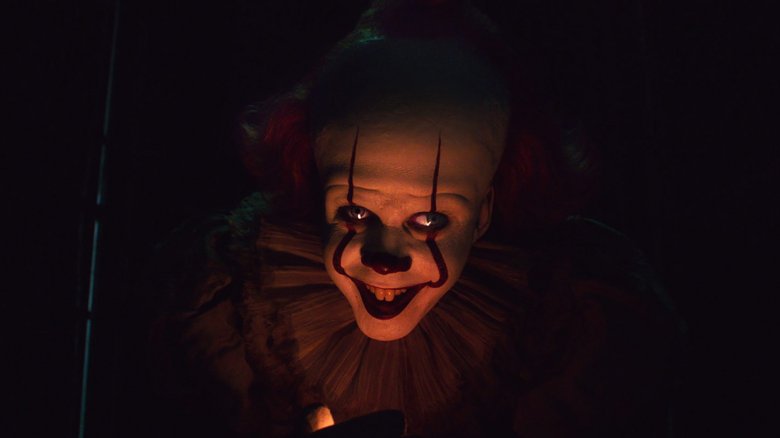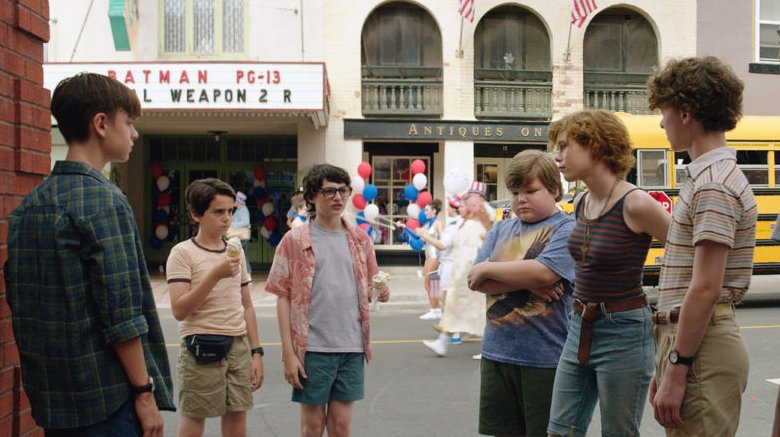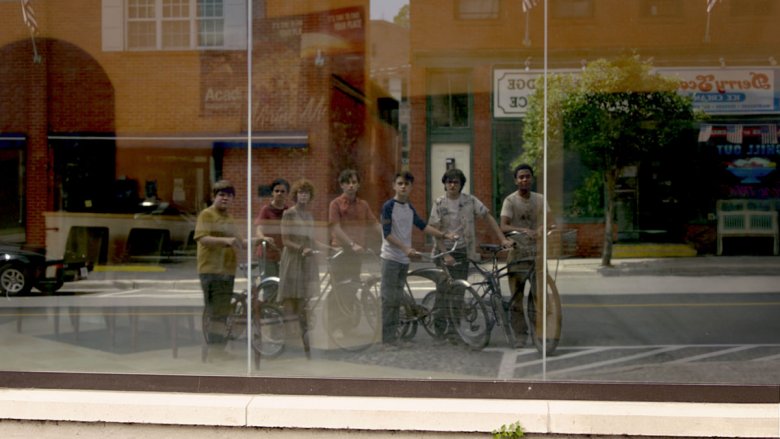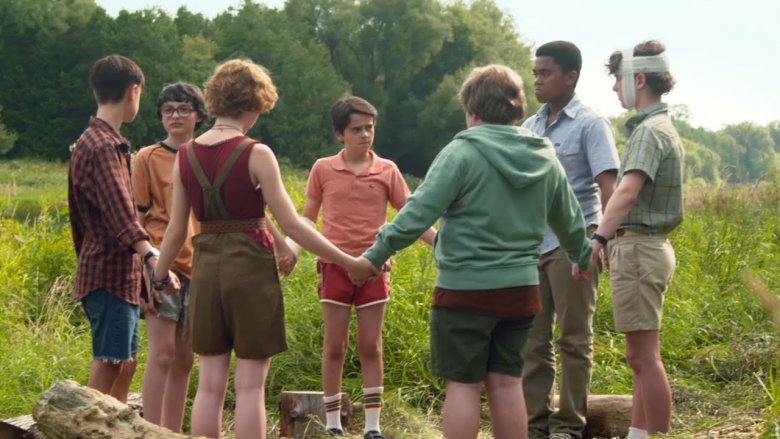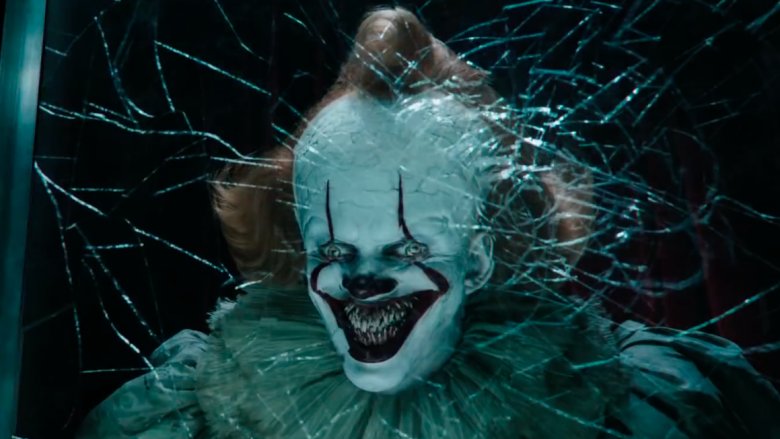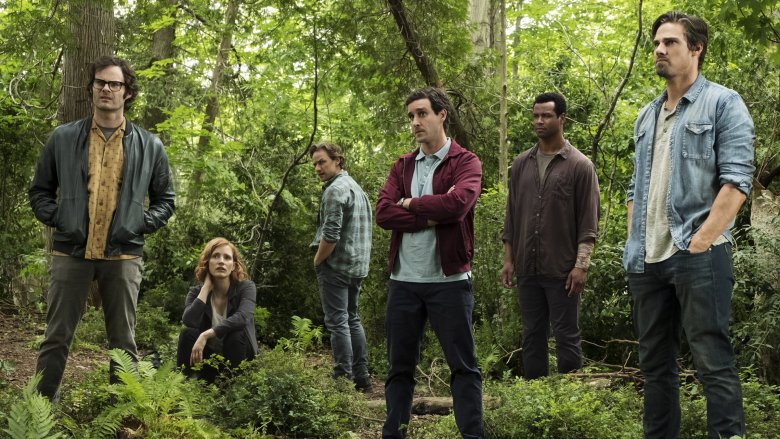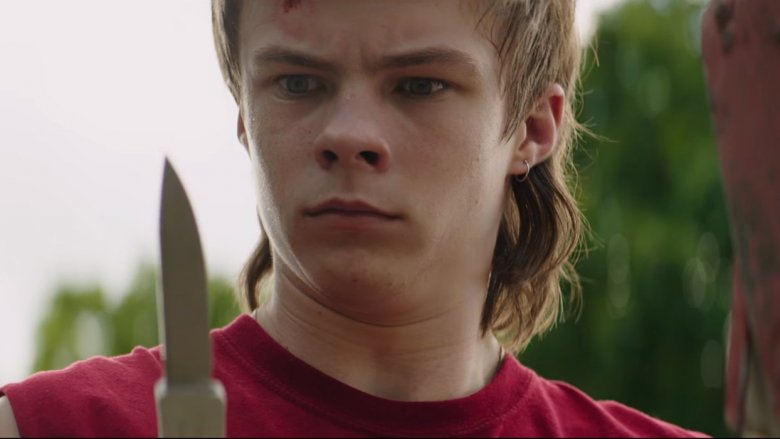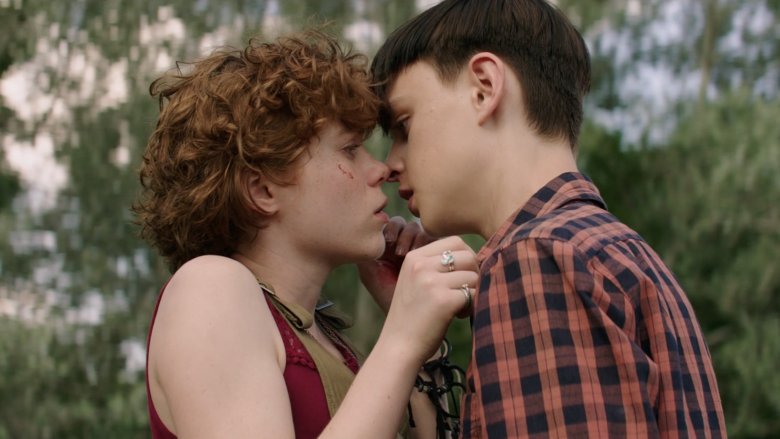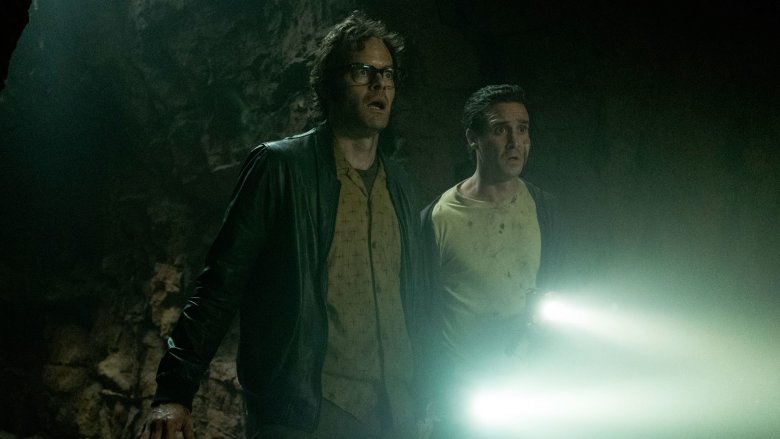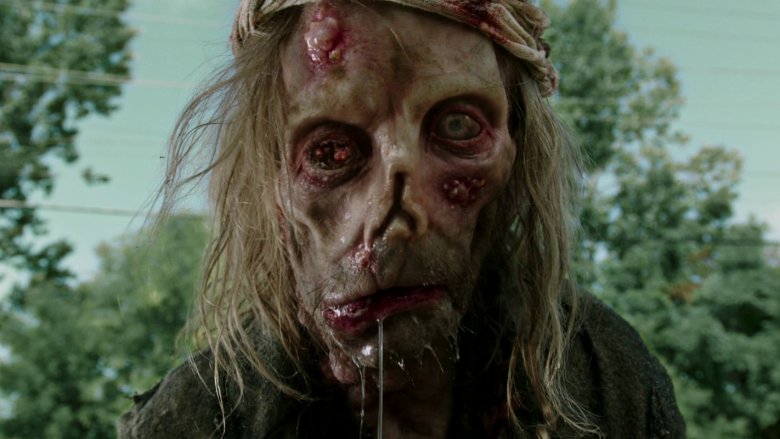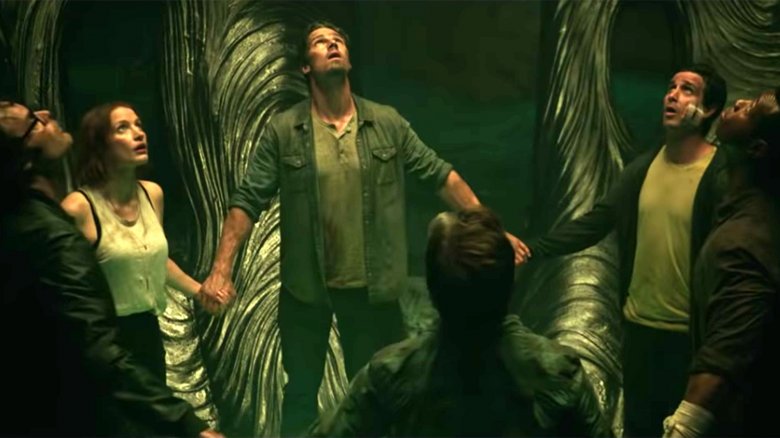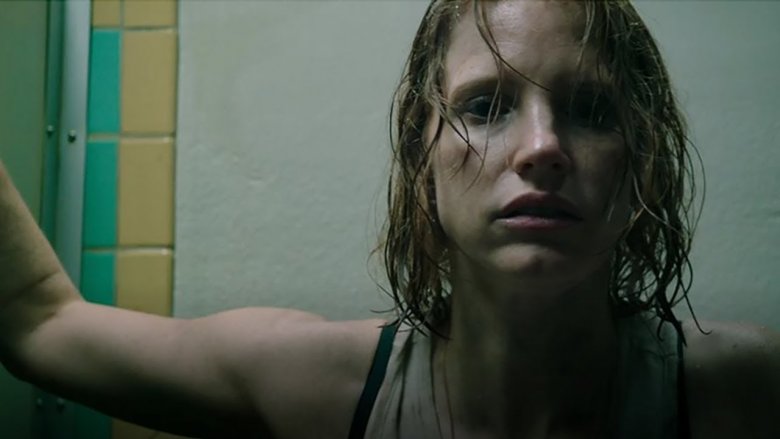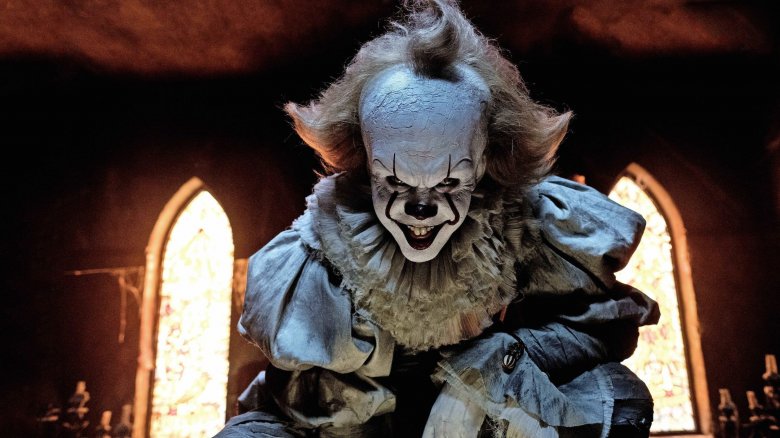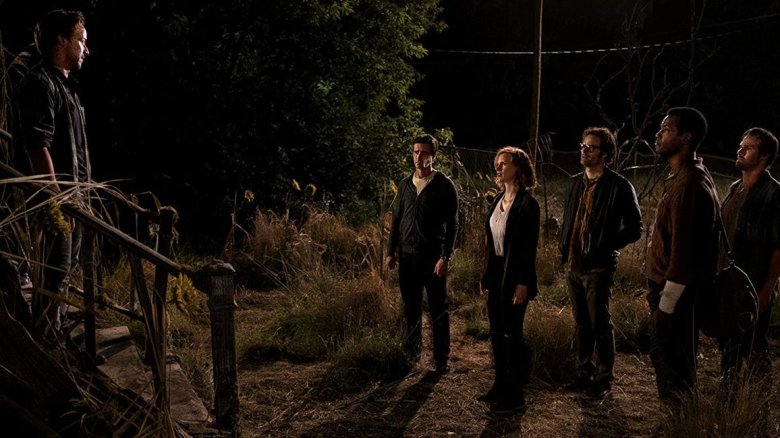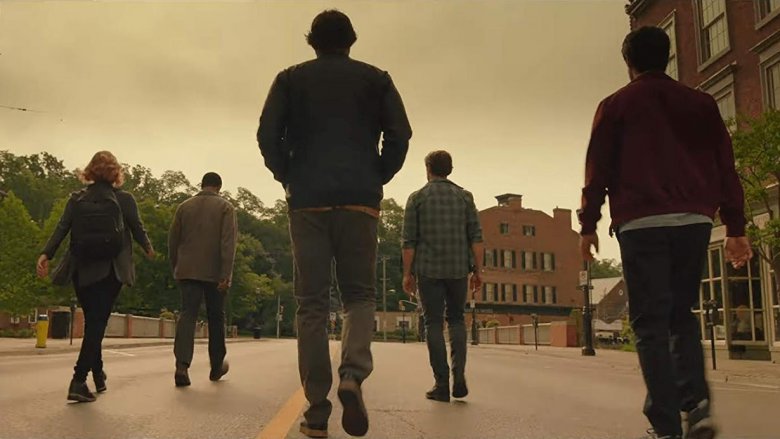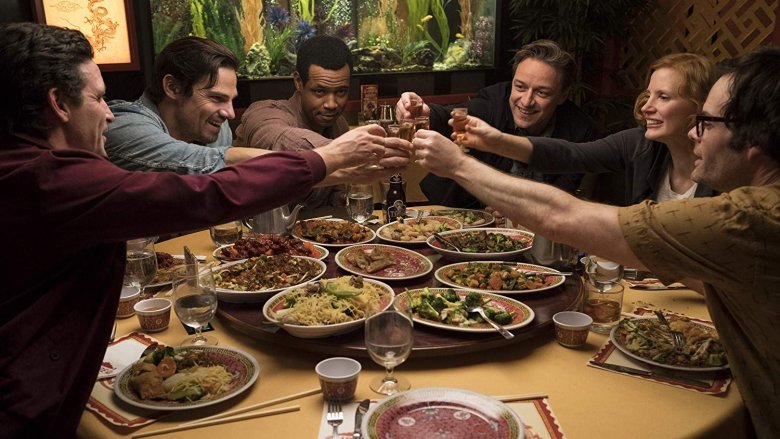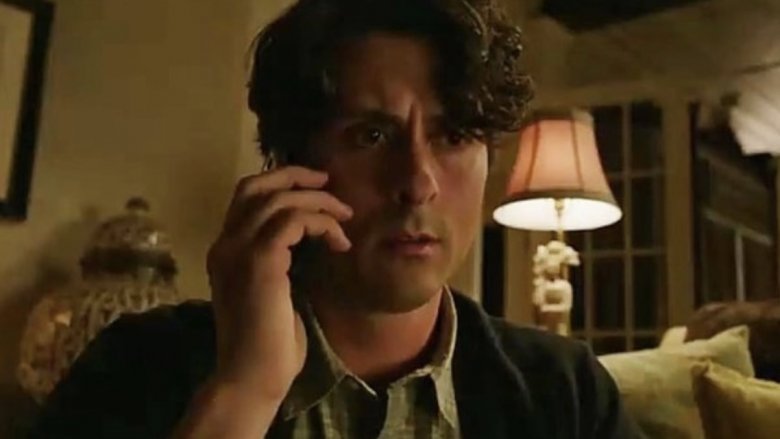How Stephen King's It Is Different From The Movies
When the first half of director Andy Muschietti's big-screen adaptation of Stephen King's IT hit theaters in 2017, it was immediately evident to fans of the original novel that Muschietti and company had taken some liberties with the source material. Although IT: Chapter One did a wonderful job of capturing the characters and the feel of the book, a lot of the novel's specifics were either significantly altered for the film, or — in the case of some of the most disturbing scenes — omitted entirely.
Now that the story is complete with the release of IT: Chapter Two, we have a more complete picture of how the films match up to the book. Much like with Chapter One, Chapter Two hews closely to the source material in some places while deviating significantly in others, but the overall effect still feels very true to what King wrote. While it may take another 27 years to touch on every single change the story of IT went through on its journey from page to screen, here are some of the most significant ones.
Shifting the timeline of IT
Both the book and the movie jump back and forth between two different time periods nearly three decades apart, but while the book alternates between 1957 and 1985, the films are set in 1989 and 2016. Considering the novel was originally released in 1986, making the '80s timeline feel tangibly recent to its readers, it makes sense that Muschietti and the screenwriters would update the film to feel contemporary to today's audiences.
Although much of Derry and the story of IT exists in what feels like a sort of timeless bubble, making the decade almost irrelevant, the modern-day setting does alter the story in a few minor but effective ways. Seeing each of the Losers react to Mike's Derry number popping up on their smartphones at the beginning of the film sets up an early sense of foreboding, while the '80s scenes include a number of fun pop culture references, including New Kids on the Block, Street Fighter, and Nightmare on Elm Street 5. And while the vicious hate crime against a gay couple that kicks off Pennywise's modern killing spree remains mostly unaltered from what King wrote, the way Adrian Mellon is portrayed before the attack is much more sympathetic in the film, lacking the casual homophobia of the book's '80s narration — which just makes his death that much harder to watch.
IT's parallel narratives are more intertwined in the book
Although both the book and the films focus on the same group of characters in two different time periods, the films draw a much firmer line between past and present, with none of the adult versions of the characters even making an appearance in IT: Chapter One. While Chapter Two isn't quite as distinct in its focus and includes a fair number of flashbacks, it's still accurate to say that Chapter One is about the kids and Chapter Two is about the adults. This is very different from King's book, which braids the two time periods so tightly together that it was initially difficult for IT fans to even imagine how Muschietti planned to split them apart.
Streamlining King's narrative likely worked to the films' benefit, since it may have felt jarring to visually jump between time periods as often as the book does, plus there's no good stopping point halfway through the book. Splitting the films into a children-centric film and an adult-centric film allowed each one to end with a climactic showdown against Pennywise, even if the kids' victory would prove tragically impermanent. However, in the book, weaving the timelines together helps underscore the novel's themes of memory and loyalty, as well as the sense that the bond between the characters and the actions they took were all fated, with scenes often ending mid-sentence in one time, only to be picked up smoothly in the other.
The professions and promises of the Losers
When we first meet the adult Losers, they haven't spoken in many years, and the book reveals what each of them has been up to since they moved away from Derry. Some of their professions remained the same from the book to the film — Bill is an author and screenwriter, Beverly is a fashion designer, Ben is an architect, and Mike is the Derry town librarian. But two of the Losers' professions were changed for the film. The screen version of Richie Tozier is now a stand-up comedian rather than a radio DJ, and instead of a limo driver, Chapter Two's Eddie Kaspbrak is now a risk assessment analyst. Both changes make perfect sense for the updated time period, and Eddie's is particularly fitting, given the incessant hypochondria that plagues him throughout both films.
The change in Eddie's job also makes it even more understandable when he — along with everyone else — initially refuses Mike's request for the adult Losers to reunite against IT. This is another departure from the book; in King's version of the story, none of the characters were exactly happy about having to fight IT again, but still felt bound by the promise they made as children. In contrast, the adult characters in the movie are all determined to leave Derry once they figure out what's going on, leaving the town at the mercy of IT, and need to be dragged back into the Losers Club kicking and screaming — sometimes literally.
The ancient origins of IT
We never learn exactly what IT is, in either the book or the movies, but both attempt to give at least a partial explanation. IT is some sort of ancient malevolent force that crashed into the Earth millions of years ago, in the spot that would one day become Derry. In both versions of the story, characters learn this backstory through a vision, but the circumstances surrounding that vision are very different in the films than in the book.
The way King wrote it, the child Losers attempt to mimic a Native ritual that Ben read about, creating a smoke-hole to try to induce visions that will help them learn more about IT. Only Mike and Richie end up being successful, and are temporarily transported millions of years into the past, where they witness IT's arrival on Earth. However, in the movie, it's the adult Mike that gets the vision, through seeking out a Native tribe that he'd heard battled IT at some point in the past. The Native Elders he meets with give him drugs that enable him to see the arrival of IT, along with the ritual their tribe used to fight IT. Mike later gives Bill a lower dose of the drug so that he can share in the vision, which is what ultimately convinces him to persuade the others that they have to fight.
The Losers' quest for tokens
In the book, after the Losers' reunion dinner at the Asian restaurant, the six adults decide to split up and move around Derry on their own, allowing instinct to guide them. The characters in the book have a feeling that in order to defeat IT, they'll need to get back into the mindset they had as children, casting aside their adult tendencies to make plans and account for contingencies, and following their guts instead. This focus on returning to a childlike perspective also leads the Losers to realize that none of them have had children, despite being fertile, a detail that further reinforces the impression that they were somehow cosmically chosen to come together against IT.
In the film, while the Losers still split up, their motivation is completely reversed. Mike tasks each of them with recovering their childhood memories through finding a "token," some sort of significant object that will help empower them to defeat IT. Having such a defined plan seems to work against the book's insistence that defeating IT will require the adult Losers to embrace the uncertainty and imagination of childhood. While it may not necessarily have worked on film to have six characters meandering aimlessly around Derry, the Losers of the book would likely be appalled by the neat checklist approach that their screen counterparts take to fighting ancient evil.
The films don't seem that interested in Henry Bowers
Henry Bowers is effectively the secondary antagonist of both the book and the films, but he's a much more menacing figure in the book. Many pages of the novel are devoted to the young Henry's psychopathic inner musings and his rotating gang of delinquents, as well as to the mindset of the adult Henry, who breaks out of the mental institution where he's been held for the past 27 years and travels back to Derry to kill the Losers under the influence of Pennywise. The book also takes pains to detail every last shred of harm Henry and his goons manage to inflict on others, and then in turn goes into graphic detail on how most of them die.
It's pretty upsetting stuff, and the movies leave out the vast majority of it. While the films keep the broad strokes of Henry's arc — including the murder of his father, his arrest for the Pennywise murders, and his subsequent breakout and return to Derry — Henry's story is largely just bones with very little meat on them, and most of the highly disturbing subplots involving his cronies are cut entirely. Henry only has one notable toady in the films — Patrick Hockstetter, who is killed early on in Chapter One and makes a grotesque reappearance in Chapter Two, standing in for a different character in the book — and even Henry's biggest moments are greatly truncated. It's almost as though the films have a more interesting villain to whom they wish to devote the majority of their time.
The love lives of the Losers
Several times throughout the book, the Losers take turns telling Beverly that they love her in an almost ritualistic manner. Once is the infamous orgy scene, which was mercifully omitted from the films, but there are several other times when, one by one, the boys take turns saying "I love you, Beverly." It seems intended to illustrate the bond between the Losers, but when it's always headed in the same direction — from the boys, toward Beverly — it doesn't fully succeed in establishing a strong group dynamic, and more seems to paint Beverly as the glue holding them all together.
The films, however, work hard to establish bonds between multiple pairings of Losers, creating a web of affection that wraps around them all. While the Ben-Beverly-Bill triangle from the book is still at play in the films, they don't all trade I-love-yous like some sort of secret handshake. Ben does tell Beverly he loves her at one point, but Mike and Bill also exchange the phrase over the phone at the end of the film, while Richie and Eddie are shown to have a close bond that is obviously present. In the books, everyone loves Beverly, but in the films, it's even clearer that they all love each other.
Richie Tozier's secret
In a big departure from the novel, Richie is revealed to have been harboring romantic feelings for Eddie ever since they were kids. In the book, the adult Richie is single, following a string of failed relationships with women, but aside from the controversial sex scene with Beverly as a child, his sexuality never really comes into play.
However, IT: Chapter Two spends much of the film hinting that Richie is hiding his sexuality, and Pennywise preys on his fear of someone discovering the truth. Richie's big fear in the book is eyeballs (which still gets a nod in Chapter Two), which is definitely creepy, but doesn't have much of an emotional weight to it. Shifting Richie's fear to something much more personal and intimate helps humanize and strengthen a character who, in the book, is mostly just comic relief, and Richie's heartbreaking reaction to Eddie's death at the end of Chapter Two helps drive home just how high the cost of the Losers' victory was. And at the end of the film, Richie's visit to the fence where he carved his and Eddie's initials as kids, and his smile as he traces the letters with his fingers, hints that his fear of discovery is now gone, killed with Pennywise.
The many manifestations of IT
In the book, while IT does assume the appearance of Pennywise a fair amount of the time, it also spends a lot of time in a number of other forms. Some of these guises are included in the films — the mummy, the leper, the Paul Bunyan statue, the disembodied head of Stan Uris — but several others are either not included or are only shown extremely briefly. In the book, IT appears to several of the children as a gigantic bird, and during the climactic battle in the tunnels, it turns into a giant eyeball and then a massive spider.
The films did include a version of the spider (albeit still wearing Pennywise's clown face), but cut way back on the rest, substituting them with new, equally disturbing Pennywise scenes, such as when the clown comes out of the projector to the kids in Chapter One. The way IT plays with the Losers' perception of reality was also altered for the films. In the book, during the scene when Beverly goes to visit her childhood home, Mrs. Kersh's house transforms into sticky, sugary candy, playing on Beverly's childhood fear of the witch from Hansel and Gretel, while the film just sees it change from the warm apartment Beverly had perceived at first to the dilapidated, abandoned building it truly was. This is just one of the many changes the films make to ITs many appearances, while still maintaining the terrifying sense that IT can be anywhere, at any time, and we may never know until it's too late.
The Losers make their final stand
In the book, Henry Bowers attacks Mike at the library, stabbing him in the femoral artery and putting him in the hospital, before heading to the hotel, where he attacks and is subsequently killed by Eddie. In the film, these events are reversed, with Henry appearing in Eddie's room first. The film also changes the mechanics of the fight itself — instead of breaking Eddie's arm, the film version of Henry stabs Eddie in the face, and instead of killing Henry with a broken water glass, Eddie stabs him with the switchblade he removed from his face. Henry then attacks Mike at the library, but the other Losers are right behind him after his attack on Eddie, and Henry is killed by Richie before he can do any serious damage to Mike.
This sets up an extremely different dynamic for the final showdown between the adult Losers and IT, since in the book, Mike is in the hospital and the rest of the group is forced to take IT on with only five people, one of whom has a broken arm. In the film, all six are present and able-bodied when they take on IT. This also eliminates the need for the scene in which Pennywise sends someone to kill Mike at the hospital, and the five Losers in the tunnels somehow sense the threat to Mike telepathically, and send him their strength just long enough for him to defend himself against the attacker.
The complications of Tom Rogan and Audra Denbrough
Several of the adult Losers are married in the novel, and those relationships all carry forward to the film. Bill married an actress named Audra, Eddie married a woman named Myra who bears an unsettling resemblance to his mother in both appearance and personality, Stan married a woman named Patty, and Beverly married her business partner Tom, a dangerous man who mirrors the abusive behavior of her father. We do meet Audra, Myra, Patty, and Tom at the beginning of Chapter Two, but that's the last we see of any of the Losers' spouses in the film (although we will hear Patty's voice one more time, when Beverly calls her and learns of Stan's death).
However, in the book, Audra and Tom have much bigger roles to play. Both follow their spouses to Derry — Audra out of concern, and Tom out of malice. Tom winds up becoming possessed by Pennywise and reliving the memories of Henry Bowers, while Audra gets visions of Beverly's past. Ultimately, both are taken to IT's lair, where Tom drops dead upon seeing its true form, and Audra goes catatonic. Bill rescues Audra and admits her to a hospital, but it's a wild ride on Bill's childhood bike, Silver, that ultimately winds up restoring Audra's mind. None of this occurs in the film, although it's implied that Beverly eventually gets a divorce.
What to expect when IT's expecting
One of the big reveals of the book that is totally ignored by the movie is the fact that IT is female, and that the version of IT that the adult Losers encounter is pregnant. This leads to an extended sequence of Ben Hanscom finding all of ITs eggs and meticulously squashing them under his feet, one by one, in addition to a lot of gendered trash talking during the final battle.
It's probably for the best that the films left this part out, leaving IT as a genderless, ageless entity. It's a little jarring to reach the end of the book and learn that IT, who has almost always chosen to present male, is actually female, and even more jarring when the Losers begin to throw violent, misogynistic slurs at it in their attempts to kill it. It's a layer the film didn't need, and losing it didn't diminish the effectiveness of the finale one bit. Meanwhile, the decision to omit IT's offspring from the film made the ending of Chapter Two feel more self-contained and definitive, without the sense that it might be teasing a sequel.
The Ritual of Chüd, the Turtle, and the deception of Mike Hanlon
IT is not the only ancient supernatural force present in Stephen King's book. There's also an ancient, cosmic turtle, which has stood in opposition to IT for ages, and which assists the child Losers in their quest to defeat IT. The turtle exists in a sort of void outside of our reality, where Bill interacts with it and it gives him the Ritual of Chüd, a battle of wills that draws on the power of Bill's childhood imagination. Chüd is how the Losers defeat IT in both timelines, although as adults, Bill's imagination is not strong enough. It's ultimately Eddie, using his imagination to turn his asthma inhaler into poison strong enough to hurt IT, that saves the Losers as adults, losing his life in the process.
While the films contain a few subtle visual nods to the turtle, that's as far as its involvement goes. Instead, the Ritual of Chüd is a Native ritual which involves the burning of the Losers' tokens in a mysterious artifact, chanting, and strong belief. Although Mike spends the entirety of Chapter Two insisting that Chüd is how they will defeat IT, it is eventually revealed that the ritual failed the Native tribe who attempted to use it, and that Mike knew the whole time. He thought that if the Losers believed it would work, that they would succeed. However, the ritual fails, and it is ultimately the Losers coming together to make Pennywise small in their minds that allows them to defeat IT, crushing its beating heart in their hands.
The destruction of Derry
The town of Derry is much more of a character in the novel than in the films, and it is strongly implied that the town itself is linked to IT and sustained by the same ancient evil. So when the adult Losers go on their final quest through the sewers to destroy IT, the town gets increasingly more wounded. Derry gets pummeled by a vicious storm, and the townspeople begin to awaken from IT's thrall, feeling for the first time as though something may be wrong.
The closer the Losers get to their goal, the more Derry suffers, with pipes exploding violently and buildings collapsing, until eventually all of downtown Derry is destroyed. After the Losers have defeated IT and are trying to get back to the surface, they have a hard time finding their way out. At first they think their difficulty is because Eddie, their navigator, has died, but realize after a piece of a movie theater marquee floats by them — advertising Aladdin, although probably not the one you're thinking of — that a big part of the problem is that Derry has collapsed into the tunnels, which is why nothing seems familiar.
The film keeps the destruction of Pennywise much more contained, with only the house on Neibolt Street collapsing in on itself after the Losers succeed. Presumably the tunnels underneath the town have also caved in, but it doesn't seem to have any impact at all on the conditions on the surface.
Don't you forget about me
One of the strange things about living in Derry, in both the book and the films, is that once you leave the town, your memory of it slowly fades, until you don't even remember that you ever lived there. A big part of the adult Losers' storylines is the effort to recover their lost memories, since until Mike called, none of them remembered knowing each other, or that they'd ever fought IT as children.
In the book, this forgetting effect doesn't change after the defeat of Pennywise. Mike and Bill stay in the town the longest, and are therefore the last to forget, but with IT gone, not even remaining in Derry is enough to safeguard their memories. Mike ends the novel musing that this forgetting must mean that IT is truly dead now, and wondering how long it will be until even his journal entries are completely erased.
However, IT: Chapter Two takes the complete opposite approach, changing King's ending for one in which the Losers all marvel at how their memories have remained intact. Instead of bidding each other sad farewells, knowing they'll never see or remember one another again, they keep in touch, with Mike calling Bill to ask how his latest novel is coming, and Beverly and Ben sailing off into the sunset together. While the film's happy ending is not as bittersweet as King's, it still serves to convey that this time, the Losers were successful, and Pennywise is indeed gone for good.
The final words of Stanley Uris
The tragic death of Stan Uris by his own hand hangs heavy over the characters in both the book and IT: Chapter Two, with his friends all assuming that he took his life because he was afraid. However, the film gives Stan a last goodbye that the book never does, in the form of identical letters he writes to each of the Losers, which he leaves for his wife to mail at some point following his death.
In Stan's final missive to his childhood friends, he explains that he didn't take his life for the reasons they probably thought. He says that he knew he couldn't bring himself to return to Derry, but that he also knew that the cosmic strength that the Losers held when they were all together might not reach its full potential if one of them was absent. Wanting to keep his promise to help defeat IT, and hoping to keep his friends alive by not diluting their strength, Stan says simply that he decided to take himself off the board. "Did it work?" he asks at the end of the letters, before concluding that if the Losers are reading his words, it probably did.
This departure from the novel winds up giving Stan a retroactive presence in that final battle, even if he isn't physically present. In his own way, Stan tried to do his part in defeating IT, even if it's not what any of the Losers had in mind when they made their vow to return. Whether this works for or against the film is up to the viewer, but giving Stan some of the final words is an effective way of communicating that, even in death, Losers stick together.
